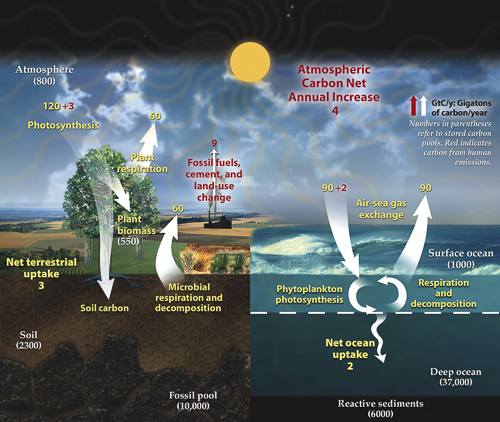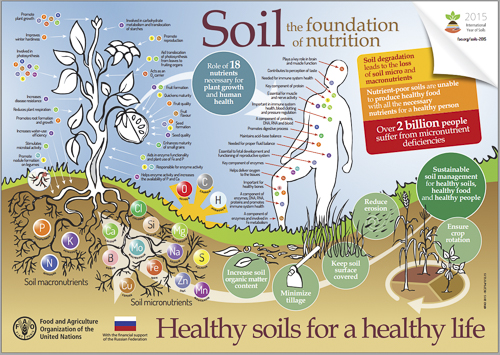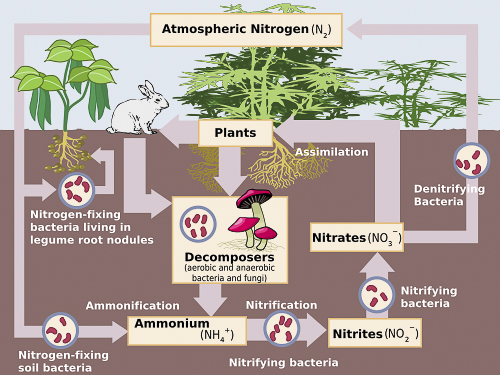Source: http://www.fao.org/3/a-bc275e.pdf
I recently went to a seminar on Man and Humus – ways to increase soil fertility .
After a short introduction by the organisers and the moderator of the seminar, rural and agrarian sociologist Bjørn Egil Flø from NIBIO held a speech on modern agriculture where farm properties are always growing, while the number of farms is decreasing, excessive consumption of water, depletion of topsoil and increased vulnerability to weather extremes are common occurrences. Struggling farmers in the U.S. are advised to buy gene-modified seeds, which they have to buy yearly and to grow plants which are drought-resistant. Instead of changing agriculture to cooperate with nature, we are told that everything can be solved by technology, while buzzwords like bio-economy are invented to follow the same, steady course.
Hugh Riley from NIBIO Apelsvoll told us about changes in soil organic matter. A quick summary follows.
Status for fertility in Norwegian field soils:
beneficial:
- long history with domestic animals on meadows.
- cool climate which has contributed to storing organic matter in soil.
- challenges given by nature:
- highly varying quality of the matter (brown earth and podzol), which affect soil acidity and soil nutrition.
- barren topsoil, dense ground, mostly hilly terrain, cool climate.
man-made threats:
- heavy machinery leads to soil compaction – permanent damage below ground.
- intensive soil preparation, in particular in autumn – increased risk for erosion .
- building on the most fertile topsoil.
- invariable ways of working the land – less organic matter in the topsoil.
High soil organic matter content:
- gives nutrition to plants.
- disables toxic chemicals.
- granular soil structure.
- higher soil water storage.
- higher exchange of gases between soil and atmosphere.
- higher soil stability and infiltration ( the process by which water on the ground surface enters the soil) leads to less erosion.
- higher absorption of sunlight (faster heating).
- high cation exchange capacity. The Exchange Capacity of soil is a measure of its ability to hold and release various elements and compounds. We are mostly concerned with the soil’s ability to hold and release plant nutrients, obviously. Specifically, the soil’s ability to hold and release positively charged nutrients.
- carbon storehouse
Conclusion:
- soil organic matter content in Norway is still decreasing, in particular in areas with a high initial level.
- practising crop rotation by turning arable land to meadows is most effective even though it’s impractical and unprofitable.
Agronomist Martin Beck from Almende, an agricultural cooperative where regenerative agriculture is practised.
Instead of starting with humus , which has several definitions and no agreed upon origin, he preferred to refer to humic substances, also described here.
They are responsible for the following benign characteristics:
- they resist microbiological/microbial decomposition.
- they stabilise the microbiological habitat in the topsoil.
- they can bind water and release hydrogen and oxygen molecules.
- they form easily available nutrients.
- they make the topsoil more porous.
5 ways to make fertile topsoil:
- create a balance between nutrients in the topsoil.
- try to grow plants on as much arable land as possible and as long as possible.
- apply fertilisation only on healthy, green plants.
- surface composting: the green plant cover is «peeled off» and mixed with the topsoil, which should be allowed to rest 5-14 days.
- at the same time as the peeling or the mixing take place, a mixture of bacteria, which will stimulate life in the topsoil, has to be applied.
Observe the plants, which are growing up. Do a brix test in order to find the sugar content in the leaves together with various trace minerals . If anything is missing, add the necessary minerals.
Adam O’Toole from NIBIO talked about biochar. It is a material, which resembles charcoal and it can be used to increase the content of carbon in soil and as a means to improve various soil characteristics. Biochar is made by means of a process called pyrolysis where organic matter is heated to a high temperature with a limited supply of oxygen.
From earlier scientific studies, the following positive effects can be expected if biochar is added to topsoil:
- increased water retention if drought-sensitive soil types.
- increased production of biomass (5-10%)
- increased carbon content in the soil.
- reduced emissions of the greenhouse gas nitrous oxide.
- improved use of nutrients in combination with animal manure or compost
Research is being made where biochar mixed with compost and bark may replace unsustainable extraction of turf in Norway in the future. Another research project called CAPTURE+ involves paying farmers to store carbon in soil by means of biochar some time in the future.
Hege Sundet from NLR Østafjells presented the Soil Carbon Project.
This project is meant to gain knowledge and experience with carbon-fixing ways of cultivation, which is adapted to Norwegian climate and agriculture. 6 farms have been selected for the project: 2 farms where sheep and cattle eat grass cultivated on the farm, 2 farms cultivating grain and 2 farms cultivating vegetables.
Sheep farmer Anders Lerberg Kopstad grew up on a conventional farm and saw that the quality of the soil was continually worsening. He took over the farm and started organic farming in 2011. It’s one of the first farms in Europe where holistic management is being used to plan how to let the sheep graze the farm’s land. The farm is called Evig grønne enger meaning Evergreen meadows.
According to Mr Lerberg Kopstad, regenerative agriculture is used to heal the soil after having been subjected to conventional agriculture for many years. The sheep contribute to rehabilitating the topsoil, which gives biological diversity and clean, grass-fed mutton and lamb meat. By means of photosynthesis , plants extract carbon dioxide from the air and finally, it ends up in the topsoil. He and his family like to call themselves carbon farmers, producing carbon-rich topsoil instead of consuming it and emitting carbon dioxide to the atmosphere. This leads to a good circle by letting solar energy lead to carbon in the topsoil, which leads to more grass, which gives more food to the sheep, which gives more meat to the customers.
Mr Lerberg Kopstad is trying to work with nature and not against it. Then, he spends less time and energy, while producing more than he would have done if he had been raising sheep in a conventional way. As a result, he hardly uses his tractor any more.
His advice to conventional farmers is to cover arable land all year, either with straw or hay or preferably with live plants. Bare topsoil gives weeds, loss of nutrients and microorganisms, evaporation and erosion. By always ensuring a healthy topsoil, everything else becomes much easier.
Grain farmer Hellek Berge from Gvarv in Telemark cultivated grain conventionally from 1988 to 2008 and started organic farming in 2008. He had been curious about organic farming for many years, but since he didn’t have any domestic animals, he was told that he couldn’t do it. Then, when the price of fertilisers went up considerably from 2008 to 2009, he decided to change to organic farming. Now he and his family are growing oats and peas and they are raising 3 Telemark cows . The main difficulties after the transition are more weeds like couch grass and creeping thistle besides, the yield has decreased to 65%, which is commonly used as an argument against organic farming. However, Mr Berge uses 1 kg of fertiliser to produce 180 kg of oats, while the winner of the Norwegian oats championship produced only 63 kg of oats with the same amount of fertiliser. In addition, the peas don’t require fertilisers at all, which improves the economy of the farm.
Mr Berge practises crop rotation with plants, which give nutrients to the topsoil and plants, which take nutrients from the topsoil. He cultivates white clover and perennial raygrass together with both oats and peas. Clover collects nitrogen at its roots, while raygrass binds the topsoil, prevents surface water drainage and erosion. After the harvest, both these plants keep growing into late autumn and they do the same in late winter, a long time before he will sow oats or peas.
Mr Berge feels that he have just started and that there is much more to learn. He also participates in the Soil Carbon project.
Afterwards, there was a discussion among the speakers and the moderator. In addition, members of the public were invited to attend, giving interesting questions to the speakers.
Regine Andersen from Oikos (renamed to Økologisk Norge) rounded off the seminar by telling us that farmers can solve the demanding tasks that food production need to meet and they can develop new methods based on the resources, which are available on their farms. Now we need to show farmers who are taking care of the earth to all of Norway and work to provide necessary political changes in order to let Norwegian agriculture become more sustainable.
The one hundred participants to the seminar got inspiration, hope and knowledge about how we can save the topsoil, which all of us depend on.
The seminar was organised by Økologisk Norge, a national movement of organic producers and consumers in Norway, the magazine Økologisk Landbruk which is issued by Norsk Landbruksrådgiving , Vitenparken Campus Ås and the foundation KORE.
For information about making compost, this reference can be referred to.
Adding carbon to soil is part of the global carbon cycle as shown in the following picture.

Source: U.S. Department of Energy Genomic Science Program
The carbon cycle is the bio-geochemical cycle by which carbon is exchanged among the biosphere, pedosphere, geosphere, hydrosphere, and atmosphere of the Earth. Carbon is the main component of biological compounds as well as a major component of many minerals such as limestone. Along with the nitrogen cycle and the water cycle, the carbon cycle comprises a sequence of events that are key to make Earth capable of sustaining life. It describes the movement of carbon as it is recycled and reused throughout the biosphere, as well as long-term processes of carbon sequestration to and release from carbon sinks.
The global carbon cycle is now usually divided into the following major reservoirs of carbon interconnected by pathways of exchange:[
- The atmosphere
- The terrestrial biosphere
- The ocean, including dissolved inorganic carbon and living and non-living marine biota
- The sediments, including fossil fuels, freshwater systems, and non-living organic material.
- The Earth’s interior (mantle and crust). These carbon stores interact with the other components through geological processes.
The carbon exchanges between reservoirs occur as the result of various chemical, physical, geological, and biological processes. The ocean contains the largest active pool of carbon near the surface of the Earth. The natural flows of carbon between the atmosphere, ocean, terrestrial ecosystems, and sediments are fairly balanced so that carbon levels would be roughly stable without human influence.
The nitrogen cycle is the biogeochemical cycle by which nitrogen is converted into multiple chemical forms as it circulates among atmosphere, terrestrial, and marine ecosystems.
The conversion of nitrogen can be carried out through both biological and physical processes. Important processes in the nitrogen cycle include fixation, ammonification, nitrification, and denitrification. The majority of Earth’s atmosphere (78%) is atmosphere nitrogen, making it the largest source of nitrogen. However, atmospheric nitrogen has limited availability for biological use, leading to a scarcity of usable nitrogen in many types of ecosystems.
The water cycle, also known as the hydrologic cycle or the hydrological cycle, describes the continuous movement of water on, above and below the surface of the Earth. The mass of water on Earth remains fairly constant over time but the partitioning of the water into the major reservoirs of ice, fresh water, saline water and atmospheric water is variable depending on a wide range of climatic variables. The water moves from one reservoir to another, such as from river to ocean, or from the ocean to the atmosphere, by the physical processes of evaporation, condensation, precipitation, infiltration, surface runoff, and subsurface flow. In doing so, the water goes through different forms: liquid, solid (ice) and vapor.



